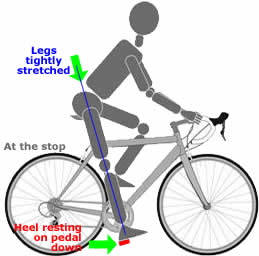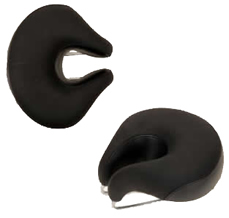


| < - > Bike — Sitting — Be heard — Push-back — Shield-oneself — Transport — Trailer — GPS — Drink — Camping — Energy |
SIT COMFORTABLY ON A BIKE
On a bike tour you sit for very long hours every day for many weeks in a row. The movements of the body on the saddle, the heat and humidity put our hind legs to the test. We therefore need very good saddles AND a good panty bottom.
SADDLE
COMFORTABLE BIKE SADDLE
The original stool is now often gel. Their basic comfort is correct.
However, being no longer 20 years old, with several weeks of cycling, the perineum and especially the prostate are not exempt from some aggressions. A prostatitis can develop!
One day, we were stopped at a traffic light next to a cyclist whose bike was equipped with a saddle that was as odd as it was strange… a horseshoe-shaped saddle!
The cyclist in question willingly told us that it was very comfortable, but that we had to be very, very patient to adapt to it. The most confusing thing was the lack of a saddle nose (the front part of the saddle that goes between the thighs).
We were intrigued and interested.
So we searched the web. We found 3 different solutions (ALLAY, SMP, ISM) to eliminate or reduce harmful pressure on the perineum:
ALLAY Solution |
SMP Solution |
ISM Touring Solution |
Inflatable saddle nose pocket |
Recess in the axis of the saddle |
Horseshoe shape |
At first glance: Very attractive solution, since it offers the possibility to inflate the pouch in the saddle nose at the desired pressure. |
At first glance: Attractive solution, by the absence of contact with the main part of the perineum, while keeping a nose to the saddle. |
At first glance: The absence of a nose must be very disturbing. |
The use: The canvas strip (located above the airbag) is very taut and too rigid. In addition, this strip is bordered by two very rigid side reinforcements. This makes it very difficult to touch, even when the airbag is completely deflated. |
The use: Good protection for the perineum… Great, it's going well… Unfortunately, the use reveals a great difficulty to stabilize on the seat. This is certainly independent of the presence of the central obviously, but rather due to the transversal profile of the seat. |
The use is immediately impeccable for the perineum. On the other hand it is VERY confusing not to have lateral stabilization of the bike through the saddle nose between the thighs. Moreover the unusual positioning of the buttocks is also confusing. |
Trial NOT CONCLUDING. |
Trial NOT CONCLUDING. |
VERY CONCLUSIVE… once acclimatised |
The further acclimatization of these ISM saddles has taken quite a long time. It took us a few hundred miles to break in.
But now we're staunch supporters, they're really our panacea.
This ISM Touring saddle allowed Martin to put an end to the chronic prostatitis that he had come to suffer from while riding his bike. For health issues related to cycling, see the page Health.
HYPER-IMPORTANT: THE RIGHT SADDLE HEIGHT
A saddle that is set too high allows maximum power, but causes tendonitis in the back of the knee; moreover, the swaying of the hips due to this position causes back pain.
If it is too low, it will make it easier to get into the saddle and to rest on the ground when stationary, but it will then lead to painful and destructive stresses in the front of the knees, as the knees work too bent.
A simple and effective adjustment procedure consists of :
- At standstill
- Low pedal
- Well horizontal basin
- Leg fully extended
- Adjust the saddle height so that the heel is well supported on the pedal.

CYCLING PANTS
CHOICE OF CYCLING PANTS
A good saddle is good. But on very long journeys a complement of cycling pants is essential.
A cycling pants that can be shorts, shorts, shorts, shorts… whatever it is according to taste. On the other hand, IN ALL CASES, comfort is WITH a chamois leather.
Don't worry, it is out of the question to massacre magnificent chamois for the comfort of our buttocks. Some people still make this outdated choice, not us.
By extension, this term refers to all the artificial materials protecting the cyclists' bottom.
These hides look like this

 they're sewn into the bottom of the pants.
they're sewn into the bottom of the pants.
There are all kinds of qualities. You have to pay close attention to the following points:
- A good thickness (not a sheet of paper as in the low end)
- A good material, a good brand… for example Gore-Bike-Wear.
- A surface large enough to ABSOLUTELY prevent the peripheral seams of the panty assembly from rubbing in the buttocks-saddle contact area.
IMPORTANT REMINDER: How to wear the chamois pants
Many cyclists don't know how to wear chamois panties.
ATTENTION : To benefit from the comfort you must NEVER WEAR SLIP. We have many friends or acquaintances who never had this information (neither from the sellers nor from the notices). From the day they were informed, their buttocks were relieved !!!
Indeed the contact must be direct between their skin (their buttocks) and the chamois leather. Otherwise it is useless and the irritation and pain continues.
On this point there are contrary opinions on the Web especially for the itinerant cyclist. All this in the name of modesty (!!!) and/or so-called hygiene.
It is obvious that for hygiene in particular and for comfort in second place (salt due to perspiration becomes irritating) the wear should not exceed one day.
The solution is simple, we have 3 privateers per person. It doesn't weigh much, and it allows a daily change of clothes. If, as is often the case, we make a stopover/visit of one day every 3 days, we then put the dirty privateers aside and wash them all at once in a laundromat/dryer in our stopover town. Otherwise a little cleaning at the wash basin every evening, and if the drying is not finished the next morning, we put it well apart from the rest. So from the evening after washing, at the latest, it is dry… And the pleasure of pedalling the buttocks at ease continues…
SENSITIVE BUTTONING and waiting for tanning
TIP for the starting phase of cycling AND sensitive buttocks :
Sensitive buttocks, not tanned by constant cycling, can still suffer during the first days of a long cycle ride.
In this case, simply take some special anti-chafing cream with you to apply to the chamois leather. It is a softening and antiseptic ointment. A dab of ointment applied in the morning before leaving allows the buttocks to run in peace and quiet.
The rest of the cycle ride is done without ointment.






